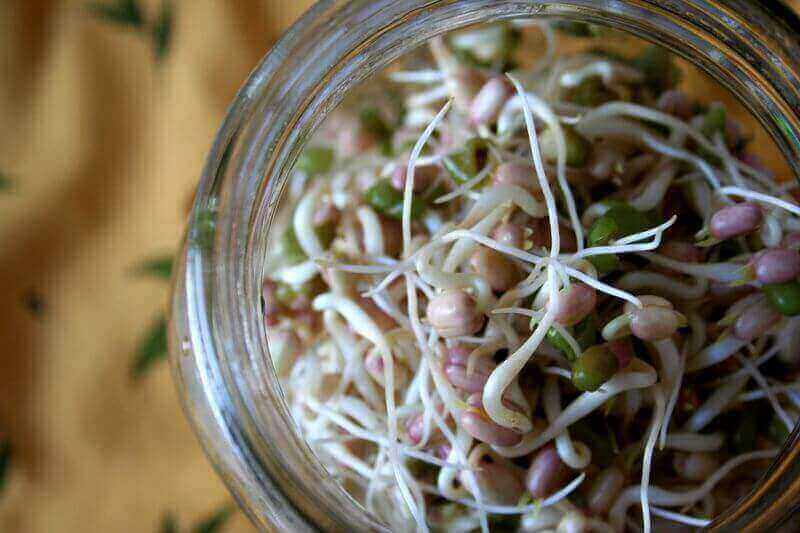Imagine the joy of witnessing nature’s magic unfold before your very eyes as you embark on the journey of sprouting seeds in a simple jar. In this article, we will explore the wonders of sprouting seeds and how you can easily bring a burst of life into your own home. From selecting the right seeds to nurturing them with tender care, get ready to discover the enchanting process of sprouting seeds in a jar. Let’s embrace the beauty of nature and unleash our green thumbs together!
Materials Needed
To start sprouting seeds in a jar, you will need a few essential materials. First, you’ll need a mason jar or a glass jar with a wide enough mouth to allow airflow. Make sure the jar is clean and free of any debris. Next, you’ll need sprouting seeds of your choice. Popular options include alfalfa, broccoli, radish, or mung bean seeds. Ensure that the seeds you choose are specifically labeled for sprouting.
In addition to seeds and a jar, you will need water to soak and rinse the seeds. It’s important to use clean, filtered water to avoid any contamination. To cover the jar during the sprouting process, you’ll need either a cheesecloth or a mesh lid. This will allow airflow while preventing any bugs or dust from entering. Lastly, you’ll need a rubber band to securely attach the cloth or mesh lid to the jar. To catch any excess water, have a bowl or dish ready.
Choosing Seeds
When selecting seeds for sprouting, it’s crucial to choose ones that are suitable for this purpose. Certain varieties of seeds are better suited for sprouting than others. Some popular options include alfalfa, broccoli, radish, and mung bean seeds. These seeds have a high success rate and usually yield delicious sprouts. However, you can also experiment with other seeds like lentils, chickpeas, or wheatgrass.
To ensure you’re consuming the best quality sprouts, opt for organic and non-GMO seeds. This ensures that your sprouts are free from any harmful pesticides or genetic modification. Organic sprouts also tend to have a richer taste and higher nutritional value. Be sure to check the packaging for certifications and labels indicating that the seeds are organic and non-GMO.
Consider any specific dietary needs you may have when choosing sprouting seeds. Some seeds may be more suitable for vegan or gluten-free diets, while others may contain allergens or have specific health benefits. It’s always a good idea to research the nutritional properties and potential allergens of the seeds before sprouting them.

Preparation
Before you begin sprouting, it’s important to properly prepare the seeds and the jar to ensure optimal growing conditions. Start by rinsing the seeds thoroughly under running water. This will remove any dirt or debris that may be present. After rinsing, inspect the seeds for any damaged or discolored ones and remove them.
Next, soak the seeds in clean water for a specified period of time, typically between 6 to 12 hours. This soaking process helps to hydrate the seeds and initiate the sprouting process. Once the soaking time is complete, drain the water from the seeds and rinse them again.
After rinsing the seeds, it’s essential to dry the jar and lids thoroughly. Any moisture left in the jar can promote the growth of mold or other unwanted bacteria. Sterilize the jar and lids by washing them with warm, soapy water or running them through the dishwasher. This will ensure a clean environment for sprouting.
Placing Seeds in the Jar
When it comes to placing the seeds in the jar, there are a few important steps to follow. First, determine the amount of seeds you want to sprout based on your needs and the size of your jar. Generally, it’s recommended to start with one to two tablespoons of seeds. As you gain more experience, you can adjust the quantity to yield your desired amount of sprouts.
Proper seed layering is crucial for successful sprouting. Spread the soaked seeds evenly across the bottom of the jar. Avoid overcrowding the seeds, as this can inhibit proper airflow and lead to mold growth. Layering the seeds evenly ensures that they have enough space to sprout without becoming tangled or compacted.
After spreading the seeds, add water to the jar. Fill the jar with clean water, making sure to cover the seeds completely. Allow the seeds to soak in the water for a few minutes before draining the excess liquid. This helps prevent oxygen deprivation and allows the sprouts to breathe.
To ensure adequate airflow, cover the jar with a cheesecloth or a mesh lid. Secure the cloth or lid with a rubber band, ensuring it is tight enough to keep the seeds in place but not so tight that it restricts airflow. The cloth or mesh lid allows the sprouts to breathe while protecting them from any insects or dust.

Caring for Sprouting Seeds
Once the seeds are in the jar and properly covered, it’s time to start caring for them to ensure healthy growth. The process mainly involves rinsing the seeds and ensuring proper drainage and environmental conditions.
Rinsing the seeds is an essential step in caring for sprouts. Rinse the seeds twice a day with clean water. Gently pour water into the jar and swish it around, ensuring all the seeds are thoroughly rinsed. This helps to remove any waste products or enzymes produced during the sprouting process.
After rinsing, it’s crucial to drain excess water from the jar to prevent the seeds from sitting in stagnant water. Invert the jar at an angle to allow the excess water to drain out. It’s important to make sure the seeds have good airflow and are not waterlogged.
Place the jar in a suitable location where the sprouts can receive indirect sunlight or bright room temperature. Direct sunlight can be too harsh for the sprouts and may result in drying out or overheating. A warm, well-ventilated area is ideal for sprout growth.
Troubleshooting
While sprouting seeds is generally a straightforward process, you may encounter certain issues along the way. Here are some troubleshooting tips for common problems:
If you notice mold or mildew growth, it’s important to act quickly. Remove any affected sprouts and rinse the remaining ones thoroughly. Adjust your rinsing frequency or the amount of water you use to ensure proper moisture levels. If the mold persists, it may be necessary to start over with new seeds and a clean jar.
If your seeds are not sprouting, they may be too old or damaged. Ensure that you are using fresh, viable seeds and follow the soaking and rinsing steps precisely. If the seeds still don’t sprout, try adjusting the environmental conditions, such as temperature or humidity.
Uneven sprouting can occur due to uneven moisture distribution or overcrowding of seeds. Ensure that you are rinsing the seeds thoroughly and draining excess water properly. Avoid overcrowding the seeds to give them enough space to sprout evenly.
A foul odor coming from the sprouts could indicate bacterial contamination. In this case, it’s best to discard the sprouts and sanitize the jar thoroughly before starting a new batch. Ensure that you are using clean, filtered water and practicing proper hygiene throughout the sprouting process.

Harvesting Sprouts
When it comes to harvesting your sprouts, timing is key. The ideal sprouting stage varies depending on the type of seed, but generally, sprouts are ready to harvest when they have developed small leaves or have reached a desirable length. Watch for signs of sprout maturity, such as fully developed leaves and a vibrant color.
To harvest the sprouts, rinse them one final time to remove any loose hulls or seed coats. You can separate them from the water by using a sieve or by gently pouring the jar contents into a clean bowl. Allow the sprouts to drain thoroughly before storing or consuming them.
Inspect the sprouts and remove any remaining husks or seed coats. These may not be as pleasant to eat and can affect the texture of the sprouts. Gently separate any clustered sprouts to ensure even distribution and easier handling.
Storing Sprouts
Proper storage is essential to maintain the freshness and quality of your sprouts. After harvesting, it’s important to ensure that the sprouts are thoroughly dry before storing them. Excess moisture can lead to spoilage and bacterial growth.
Store the sprouts in a clean and airtight container in the refrigerator. Place a paper towel in the container to absorb any excess moisture and change it regularly. Properly stored, sprouts can stay fresh for up to a week, although it’s best to consume them within a few days for the best taste and nutritional value.

Using Sprouts
Sprouts can be a versatile and nutritious addition to a variety of dishes. Here are some ideas for incorporating sprouts into your meals:
- Add sprouts to salads for an extra crunch and boost of nutrients. They can provide a fresh and vibrant element to both green salads and grain-based salads.
- Use sprouts as a flavorful and nutritious filling in sandwiches or wraps. They add a unique texture and taste while providing additional vitamins and minerals.
- Blend sprouts into smoothies for an added nutrient boost. They can add a fresh, green flavor and contribute to the overall healthfulness of your drink.
- Sprinkle sprouts on top of soups, stir-fries, or omelets as a garnish. They can add freshness and a pop of color while enhancing the overall taste and visual appeal of your dishes.
Benefits of Sprouting
There are many benefits to sprouting seeds at home. Here are a few:
- Sprouting increases the availability and absorption of nutrients present in seeds. It unlocks and enhances their nutritional value, making them easier to digest and absorb for your body.
- Sprouts are known for their improved digestibility compared to unsprouted seeds. The sprouting process breaks down complex carbohydrates and reduces the levels of antinutrients, making them more easily digestible.
- Sprouts have been found to have higher levels of antioxidants compared to their unsprouted counterparts. Antioxidants play a key role in protecting the cells from oxidative stress and reducing the risk of chronic diseases.
- As sprouts are typically low in calories and rich in fiber, they can be a valuable addition to a balanced diet for weight management. The fiber content promotes feelings of fullness and aids in digestion, helping to maintain a healthy weight.

Safety Considerations
While sprouting seeds in a jar is a rewarding and enjoyable process, it’s crucial to be aware of certain safety considerations:
- Some seeds are not suitable for sprouting due to potential contamination or safety risks. Avoid sprouting seeds such as kidney beans, which contain a toxin called lectin that is only destroyed when cooked at high temperatures.
- Bacterial contamination is a potential risk when sprouting seeds. To minimize the risk, ensure that all equipment and surfaces are clean and sanitized. Use filtered water for rinsing and avoid soaking the seeds for an excessively long period of time.
- Practicing proper hygiene throughout the sprouting process is essential. Wash your hands thoroughly before handling the seeds or jar. Avoid touching the sprouts with bare hands to prevent the transfer of bacteria.
Sprouting seeds in a jar is a simple and cost-effective way to enjoy fresh and nutritious sprouts at home. Whether you incorporate them into salads, sandwiches, or smoothies, sprouts can add a delicious and healthful element to your meals. By following these guidelines and troubleshooting tips, you’ll be on your way to successfully growing and enjoying your own sprouts in no time. Happy sprouting!

